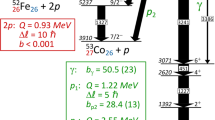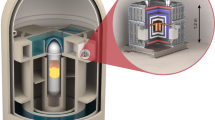Abstract
THE hypothesis is put forward that positive electron, neutrino, positive proton and neutron are four different quantum states of one elementary particle. Such an assumption would be trivial unless transitions between the different states occur. It is required that Dirac's equation follows from the theory, and that the conservation law of electric charge holds, so only a small number of transitions are allowed. If in addition we satisfy a certain symmetry condition (corresponding to the conservation law of Jordan's neutrino charge1) the number of possible processes is further reduced. The permitted transitions are: (I) positive electron neutrino (II) positive electron neutron (III) positive proton neutrino (IV) positive proton neutron. Any one of these transmutations can occur only if another one of them takes place in the reverse direction.
This is a preview of subscription content, access via your institution
Access options
Subscribe to this journal
Receive 51 print issues and online access
$199.00 per year
only $3.90 per issue
Buy this article
- Purchase on SpringerLink
- Instant access to full article PDF
Prices may be subject to local taxes which are calculated during checkout
Similar content being viewed by others
References
Jordan, Z. Phys., 98, 759 (1936).
E. Fermi, Z. Phys., 88, 161 (1934); Konopinsky and Uhlenbeck, Phys. Rev., 48, 7 and 107 (1936).
Majorana, Z. Phys., 82, 137 (1933).
To be published in the Helv. Phys. Acta. Note added in proof: It seems worth while to point out that combinations between (I) and (III) or between (II) and (IV) which lead to destruction of heavy particles, cannot occur if the negative electron and the positive proton are both considered as true particles (being the opposite of the holes or antiparticles in Dirac's theory).
L. de Broglie, ” Une nouvelle conception de la lumière”, Actualité scient., Hermann, Paris (1934). Further progress has been accomplished by Wentzel, Jordan, Kronig and Scherzer ; for references compare Jordan (ref. 1) and Z. Phys., 99, 112 (1936). See also Kronig, NATURE, 137, 149 (1936).
Author information
Authors and Affiliations
Rights and permissions
About this article
Cite this article
STUECKELBERG, E. Radioactive -Decay and Nuclear Exchange Force as a Consequence of a Unitary Field Theory. Nature 137, 1032 (1936). https://doi.org/10.1038/1371032a0
Issue date:
DOI: https://doi.org/10.1038/1371032a0



